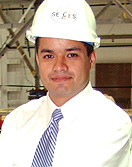News
UB engineer in Chile to see how hospitals fared in quake
The UB engineer who developed the world’s first apparatus designed to realistically test how building contents, architectural components and equipment (called nonstructural components) fare during earthquakes left for Chile on Friday on a week-long reconnaissance mission to see firsthand what kind of damage hospitals and tall, engineered buildings sustained during the powerful, 8.8 magnitude earthquake that hit the South American country on Feb. 27.
Gilberto Mosqueda, assistant professor of civil, structural and environmental engineering, and a researcher at MCEER, the Multidisciplinary Center for Earthquake Engineering Research headquartered at UB, is in Chile as part of a national team organized by the Earthquake Engineering Research Institute.
As an expert on the seismic behavior of nonstructural components, Mosqueda told the UB Reporter before he left Buffalo that his priority was to get to Chile as soon as possible.
“Unlike a collapsed building, nonstructural components like equipment, ceiling tiles and a building’s interior systems are the things that tend to get cleaned up pretty quickly after an earthquake,” he said. “That’s why we want to get there as soon as possible to observe what was damaged and how.”
He added that data gathered on this trip will be directly applicable to mitigating seismic damage in the U.S.
“Chile has good seismic-design standards for buildings and good engineers to apply and enforce them,” Mosqueda said, “and there is much collaboration between our two countries in engineering.” Mosqueda, for example, coordinates a memorandum of understanding in earthquake engineering research between MCEER and the University of Chile in Santiago.
In addition, he said, many of Chile’s earthquake engineers are graduates of UB or other U.S. institutions; while in Chile, Mosqueda is working directly with two UB graduates, one of whom is a Chilean native currently living in Santiago.
Mosqueda is looking, in particular, at hospitals in Chile to see the differences between the hospitals that did and did not collapse, as well as the state of their contents.
A report from the Pan American Health Organization estimated that 10 health care facilities were rendered inoperable by the earthquake and the tsunami that followed.
“The idea is to observe how nonstructural components were damaged and how much risk of harm they posed to individuals and the functionality of the building,” Mosqueda said. “Once we better understand how these components are damaged, we can come up with improved solutions for their installation.”
Mosqueda, who is a native Spanish speaker, is working with two graduates of the earthquake engineering program in the UB School of Engineering and Applied Sciences: Gokhan Pekcan, assistant professor at the University of Nevada, Reno, and Rodrigo Retamales, a professional engineer in Chile.
The data gathered and brought back by Mosqueda and his colleagues will have special relevance to improving the earthquake engineering of structures in the U.S.
“Chile has the strongest economy in Latin America,” says Andre Filiatrault, UB professor of civil engineering and MCEER director. “It’s a country with a lot of experience with earthquakes and you could argue that their level of preparedness is somewhat similar to the U.S., so the damage that Chile sustained may be similar to what could happen in the U.S. with an earthquake of similar magnitude.”


Reader Comments